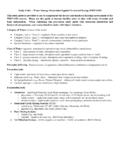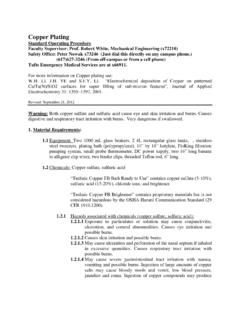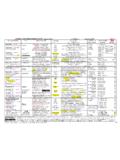Transcription of Study Guide – Applied Structural Drying and …
1 Study Guide Applied Structural Drying and water Damage Restoration This Study Guide is provided to you to complement the lecture and hands-on learning environment of the WRT / ASD courses. Please use this Guide to become familiar prior to class with terms, formulas and basic information. When combining this pre-course Study Guide with classroom instruction and homework assignments, your exam should be easier with higher retention. Category of water : (the source of the water ). Category 1 (previously known as clean ) - originates from a sanitary water source Category 2 (previously known as gray ) contaminated; potentially causes discomfort or sickness Category 3 (previously known as black ) grossly contaminated; includes toxins, pathogens Special Situations regulated or hazardous materials (IEP recommended in most situations). Class of water : (quantity; anticipated evaporation rate; initial dehumidifier calculations).
2 Class 1 least amount of water , absorption and evaporation Class 2 - large amount of water , absorption and evaporation (carpet; cushion; base of walls). Class 3 greatest amount of water , absorption and evaporation (ceiling; walls; insulation; flooring). Class 4 specialty Drying ( , hardwood; lath and plaster; concrete) deep pockets of saturation;. requires controlled Drying techniques, low vapor pressure, specialty equipment probable Principles of Drying : Remove excess / Evaporation / Dehumidification (ventilation) / Temperature control Extraction tools: Light wand perimeter of water loss; extract glue-down carpets; follow-up extraction-stationary tool Stationary tool ( , water claw; Flash Xtractor) subsurface tool; extract carpet/cushion together Self-propelled tools ( , Rover; Xtreme Xtractor) self-propelled riding tool; multi-speed; extract carpet and cushion Vacuum squeegee concrete; hardwood; vinyl; laminate Submersion pumps - Formula (ft2 x inches deep) 12 = ft3 water x = water volume Evaporation tools: Airmovers centrifugal (laminar); axial (high-amperage; low-amperage; focus ability).
3 O placement 1 for every 10-16 linear ft. of wall area; 5-45 degree focus; almost touching wall o safety screens intake and output areas; clean with compressed air; do not block intake o electrical safety lightweight extension cords; three-prong plugs; electrical cord safety Structural Cavity Drying Systems (SCDS). o Vented-ducted ( , Turbovents 18 -48 widths; Octi-dry; Air Wolf). o injected ( , Injectidry; Dri-Force; Omni-dry; Direct-it In). Floor Drying Systems o vented ( , Air Wolf). o injected negative air mats/panels ( , Dri-Force; Injectidry). o air-blanket style Air Filtration Devices AFDs (negative air machines - NAM; air scrubbers; HEPA filters). 2 Dehumidifier Ranges: Understanding where temperature, RH, and GPP ratings are out of working ranges Type: Reduced Performance if at or below: Type Dehumidifier Relative Humidity Humidity Ratio (gpp) Conventional 40% 55 Low Grain Refrigerant (LGR) 30% 34 Desiccant (with silica gel) 10% - below 10- 15 - below Refrigerants Most efficient operating conditions 70 - 90 F.
4 (most energy efficient is an LGR). Desiccants most efficient with incoming air from coolest/driest air possible; capable of creating greatest pressure differentials (air and vapor pressures); produces low humidity ratio (gpp) important to dry Class 4 materials, dense materials, and complex systems. Uses - closed- Drying environments; multiple layers of materials; security limitations; high outside (and inside) humidity conditions; no ventilation ports; basement areas Initial dehumidification recommendations (psychrometric readings dictate requirements after first day). Type Class 1 Class 2 Class 3 Class 4. Conventional 100 40 30 N/A. LGR 100 50 40 50. Desiccant 1 ACH 2 ACH 3 ACH 2 ACH. ( 60) ( 30) ( 20) ( 30). Electrical / Heat / Energy: Amperes (amperage or amps ) the amount of electricity (current) flowing in a circuit Voltage the force of electricity flow in a circuit Watts the amount of electricity an electrical device uses when operating British Thermal Units (BTU) heat generated by electrical device o Formula amps x volts x = British Thermal Units (Btu) per hour o HVAC cooling ability to remove 12,000 Btu per ton per hour Residential v.
5 Commercial - generally, residential 15 amp / commercial 20 amp (consider never using over 80% of available amperage). 220 splitters use where there is limited amperage or fuses (typically, 30 amp-dryer/50 amp-range). Light weight extension cords (shock/fire hazards). Power consumption $ formula volts x amps x 24 hours = watts 1000 = kW x cost per kW @ day 3 Inspection equipment: Moisture sensor senses moisture in materials over 17% MC; helps determine perimeter of water damage; unable to determine which layer is wet or when dry Thermo-hygrometer determines temperature / RH in all required atmospheric areas of inspection;. helps determine open or closed Drying system; further determines dehumidifier recommendations after initial placement Moisture meters invasive and non-invasive; determines moisture content; establish, monitor and determine when dry standards are met Miscellaneous infrared camera and thermometer; manometer; borescope; data logger Chemicals / biocides (antimicrobial biocides).
6 Sterilizer; disinfectant; sanitizer Written informed consent to customer; advise occupants to leave during application; document HEPA High Efficiency Particulate Air ( capture rate of particulates at .3 micron size). Government-registered disinfectants document application details; apply only per label directions EPA Environmental Protection Agency ( federal agency with regulatory control over biocides). Federal Insecticide, Fungicide and Rodenticide Act federal regulations administered by EPA. Floorcovering carpet: installation methods stretch-in, direct glue-down, double glue-down Drying methods in-place, full float, partial float construction woven Axminster, Wilton; usually natural fibers; tufted primarily synthetic delamination separation of primary from secondary backing; laminate strength loss up to 85%. when wet (causes over-aggressive extraction; flapping vs.)
7 Floating; improper cushion; urine;. folding; improper carpet stretch). Category 3 must remove and dispose; IEP possibly required for testing; if Category 2 hot water extraction of carpet required if saved; ground surface water intrusion also known as Category 3. Floorcovering cushion (also known as padding, underlay): types foam (prime, bonded urethane); rubber; felt (hair/jute, synthetic); porous and non-porous Category 2 and 3 - remove and properly dispose Floorcovering wood (strip wood, plank wood, engineered laminated wood, parquet). non-destructive (non-rotting) fungal growth - over 16% MC. destructive (wood-rotting) fungal growth over 20% MC. fiber saturation ( wet rot ) cell walls full / dimensional change stops 28 30% MC. damages from moisture - (cupping from wood edges and bottom; crowning; buckling; heaving). dry within 2-4 percentage points of EMC - Drying goal Floorcovering (laminate; resilient, ceramic tile).
8 Limitations (trapped water , potential asbestos, ceramic tile sealed grout; trapped water ). layers of floorcovering; dry flooring as a system 4 Microbiology (fungus; bacteria; virus). conditions for growth o organic food source (cellulose). o moisture (or high humidity). o temperature (most prolific 68-86 F. / 20-30 C.). o stagnant air o time (some 1-2 days; others up to 10-12 days in chronic conditions). ANSI/IICRC S520 Standard and Reference Guide for Professional Mold Remediation Indoor Environmental Professional (IEP) specialized experts may be required Mycotoxin a potentially harmful metabolite produced by some fungi, especially molds. Endotoxin a portion of the outer cell wall of some gram-negative bacteria. When ingested or respired, endotoxins can cause fever, changes in white blood cell counts, increased airway resistance, shock and even death.
9 Psychrometry definitions: Psychrometry Study of the relationship between air, humidity and temperature and their effect on various materials and comfort levels Psychrometric chart chart consisting of lines and curves that shows the relationship between air volume, temperature and relative humidity, and from which a variety of other information (humidity ratio-gpp, dew point, vapor pressure, etc.) relating to Drying may be determined Dew point the temperature at which humidity in air reaches saturation (100% RH) and will condense from that air to form condensation or dew on surfaces. Infiltration migration of air into and area from outside area due to high VP differential Equilibrium RH when air is in equilibrium with the built environment ( , the air is neither gaining moisture from, nor losing it to the material; or the point at which a hygroscopic material is neither gaining nor losing moisture).
10 Evaporation the process of changing a liquid to a vapor Primary damage damage sustained as a result of direct exposure with water . Secondary damage damage sustained from indirect or prolonged exposure to disaster contaminants Relative Humidity (RH) the amount of moisture in a given volume of air, expressed as a percentage of the total moisture holding capacity of that volume of air, at a given temperature. As temperature increases, humidity relative' to the total air volume decreases; conversely, as temperature decreases, RH increases (inversely proportional). Humidity ratio (previously known as specific humidity) the weight of suspended moisture in air expressed in grains per pound (gpp) of dry air (14 cubic feet of dry air equals one pound). 7000 grains of water vapor equals one pound of water . As humidity ratio (specific humidity).




